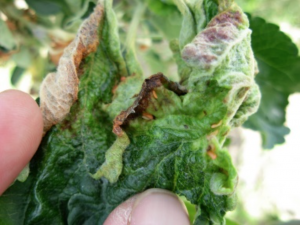Compiled by Tianna Dupont, WSU Extension, 28 April 2020.
A few insights from British Columbia where Apple Leaf Curl Midge has been detected since 2003.

A pest of apples, including ornamental malus species, the larvae feed in the growing shoots, causing gall-like thickening and rolling the leaves. The growing point can be killed, causing stunting or branching of the shoot. Generally, damage is not significant in mature trees but can cause noticeable damage in nursery trees.
Most Washington growing areas are still not affected. Our neighbors in Canada have had populations of the Apple Leaf Curling Midge in the Frasier River Delta and the Okanagan Valley for a number of years. In Washington, it has been detected west of the Cascades in Whatcom and Skagit Counties and east of the Cascades in Okanogan county (just south of the Canadian border) and in the Othello region of the Columbia Basin.

If you have had this insect in the past, pheromone traps can be a useful monitoring tool to time sprays. Traps will detect the first generation emerging from the soil in May as well as subsequent generations (2-3). Traps were developed in the UK to catch the males and are used in Canada. The male midges are easy to identify by the bright red pools of hemolymph at the end of their long legs when they are stuck in the traps. Two traps should be sufficient to monitor up to five acres of a uniform orchard. Use higher numbers in irregular fields, or in problematic areas where damage has occurred in the past. One lure will last for the season. Change the sticky card weekly. It is estimated that 10 midges in a trap for a particular generation can result in approx. 800 galls being formed per acre for that generation (Krahn, G.).

In the UK and Canada Spirotetramat (Movento) has been effective, but timing is important. Sprays must be targeted for when adults are flying (generally monthly, first often immediately after petal fall). Once you see larvae in the leaves, spray effectiveness decreases. The larvae are well protected in the curled-up leaves. Dr Joanne Cossentine, AgriFood Canada is also looking at biological control.
Remember to-date this pest is not widespread and seems to only be important in young trees. Be aware so that you have more tools if it becomes a problem in your area.
Where to order traps: Great Lakes IPM, Inc. Michigan, USA www.greatlakesipm.com; Agralan Ltd, www.agralan.co.uk
For more information
https://treefruit.wsu.edu/crop-protection/opm/apple-leafcurling-midge/
Thank you to information provided by Lindsay Hainstock, BC Tree Fruits Cooperative; Gayle Krahn, Jealous Fruits; Jerry Cross, UK
Contact
Tianna DuPont
WSU Extension Specialist, Tree Fruit
tianna.dupont@wsu.edu
Office: (509) 293-8758
Mobile: (509) 713-5346
Treefruit.wsu.edu articles may only be republished with prior author permission © Washington State University. Republished articles with permission must include: “Originally published by Washington State Tree Fruit Extension Fruit Matters at treefruit.wsu.edu” along with author(s) name, and a link to the original article.
